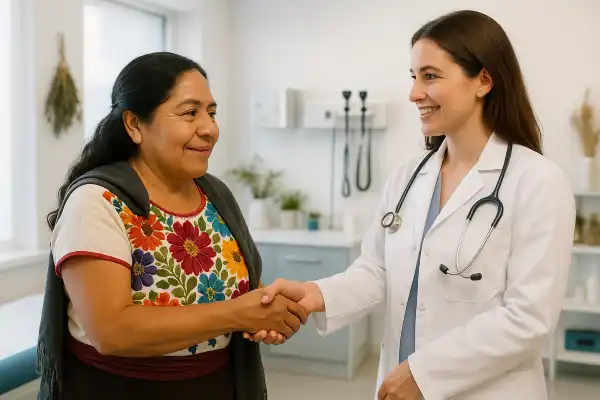Why visit a curandera instead of a doctor? This question emerges from deep within the hearts of those who sense that healing extends beyond what conventional medicine alone can offer. In our modern world, where technology often overshadows tradition, many find themselves yearning for a more complete approach to wellness—one that honors the sacred connection between body, mind, and spirit.
María del Pilar Fernández understands this longing intimately. Through her lifelong immersion in curanderismo, she has witnessed how these ancient healing arts can restore balance where other methods may fall short. Her dedication to preserving these sacred traditions stems from a profound belief that our ancestors’ wisdom holds keys to healing that remain as relevant today as they were centuries ago.
Why visit a curandera instead of a doctor?
People visit curanderas for profound reasons that touch the very essence of what it means to be human. These traditional healers offer holistic care that addresses not just physical symptoms, but the emotional, spiritual, and energetic imbalances that often lie at the root of our suffering.

Holistic healing for body, mind, and spirit
Curanderismo addresses the complete person through a holistic approach that recognizes physical, social, emotional, mental, and spiritual dimensions of health. Unlike conventional medicine, which often treats symptoms in isolation, curanderas work with the understanding that true healing requires restoring harmony across all aspects of a person’s being.
Ancient Mexican healing practices demonstrate how disease and illness are rooted in emotion, environmental imbalance or disharmony, malevolent forces, spiritual disconnection, or loss of soul. This comprehensive worldview allows curanderas to identify and address causes that might be overlooked in traditional medical settings.
The practice encompasses various healing modalities. Curanderas use ritual objects, plática (heart-to-heart conversation), plants and herbs, song, and prayer for physical healing; prayer and meditation to communicate with spiritual beings for guidance and spiritual healing power; and mental focus, visualization, and directing healing energy at the non-local level.
Cultural connection and ancestral wisdom
For many, especially those of Mexican and Latin American heritage, visiting a curandera represents a powerful reconnection to ancestral wisdom. In a land full of migrants, curanderismo serves as one of the only ways to reconnect to cultural roots and tap into ancestral memory.
Traditional Mexican Medicine has been practiced for over 5,000 years and encompasses various healing methodologies including herbalism and plant medicine, bodywork, rituals, spiritual healing, and bone-setting. This ancient lineage carries profound wisdom about natural healing that has been preserved through oral tradition from generation to generation.
The cultural aspect of healing cannot be understated. Many clients find comfort in working with healers who understand their cultural background, language, and specific spiritual beliefs. This cultural resonance often facilitates deeper healing than might be possible in conventional medical settings where cultural context may be overlooked.
Accessibility and community-centered care
People seek curanderos because they’re generally more affordable than Western Medicine practitioners, and they address immigration language barriers and other cultural issues. Many curanderas practice on a donation-only basis, making healing accessible to those who might not otherwise afford healthcare.
Unlike traditional therapists, many curanderas practice on a strict donation-only policy, eschewing the exchange of money for their services, just as their grandmothers did. This approach reflects the spiritual nature of the calling and ensures that healing remains available to all who need it, regardless of economic circumstances.
Curanderas often serve as pillars within their communities, providing not just healing but guidance, wisdom, and emotional support. Each curandera has a distinctive practice that is most often learned within the context of her family, community, or tribal nation, creating deep bonds of trust and understanding with those they serve.
Addressing spiritual and emotional illnesses
Curanderos’ duties cover not only physical ailments but also psychological and interpersonal issues, treating everything from mundane stomach aches to spiritual illnesses such as susto, mal de ojo, and even reversing negative spiritual influences. Traditional communities understand that many health issues stem from spiritual imbalances that require specialized attention.
For thousands of years, Latin American and Hispanic people have relied on curanderos for physical, mental, emotional, and spiritual healing, with practitioners having deep cultural and spiritual knowledge passed down through generations.
Specific conditions that curanderas commonly treat include susto (soul loss often caused by trauma or fright), mal de ojo (evil eye), empacho (spiritual and physical blockages), and various forms of spiritual disturbances. These conditions are recognized within traditional Mexican culture but may not be understood or addressed in conventional medical settings.
Complementary to modern medicine
Many people come to curanderismo classes seeking balance in their lives after giving modern medicine an opportunity but finding that there are certain areas of human experience that it doesn’t address or doesn’t consider as important when treating patients.
A curandera with decades of experience believes in and encourages a thoughtful inclusion of traditional Indigenous healing practices alongside a doctor’s conventional medical treatments, as may be appropriate. This integrative approach recognizes the value of both traditional and modern healing methods.
Modern curanderas often work in conjunction with conventional healthcare providers, understanding that different healing modalities can complement each other. This collaborative approach ensures that clients receive comprehensive care that addresses all aspects of their wellbeing.
Specialized healing practices
Curanderismo encompasses various specializations, each addressing different aspects of healing. Some curanderas specialize as yerberas (herbalists), sobadoras (traditional bodyworkers), hueseros (bonesetters), or focus on pláticas (heart-to-heart healing conversations).
Many curanderas perform limpias (spiritual cleansings) using eggs, herbs, and prayers to remove negative energy and reveal spiritual blockages. These ceremonies help restore energetic balance and can provide profound healing for those suffering from spiritual disturbances.
The diversity of practices means that individuals can find curanderas who specialize in their particular needs, whether those involve physical ailments, emotional trauma, spiritual disturbances, or general wellness maintenance.
Disclaimer
Please note that Maria is not a physician, psychologist, or nurse. These culture-specific spiritual healing services are not meant to replace medical or psychological diagnosis and treatment. It is recommended that you see a licensed physician or licensed health care professional for any physical or psychological ailment you may have.
Recently, María received a visit from Catalina, a young mother from Guadalajara who had been struggling with persistent anxiety and digestive issues that conventional medicine couldn’t fully resolve. During their plática, María learned that Catalina had experienced a traumatic car accident months earlier and suspected she was suffering from susto—a condition where part of the soul becomes frightened and disconnects from the body.
María began with a gentle limpia, using a fresh egg to draw out the negative energy while offering prayers for Catalina’s healing. She prepared a special tea blend of hierba buena and manzanilla to calm both her nervous system and her stomach. Throughout the session, María encouraged Catalina to speak from her heart about the accident and her fears, helping her release the trauma that had become lodged in her body.
By the end of their time together, Catalina reported feeling lighter and more centered than she had in months. María sent her home with herbs for tea and specific prayers to continue her healing, reminding her that recovery is a journey that honors both the body’s wisdom and the spirit’s need for peace. Three weeks later, Catalina returned to share that her anxiety had greatly diminished and her digestive issues had resolved, crediting the curandera work with helping her reclaim the part of herself that had been lost in trauma.
